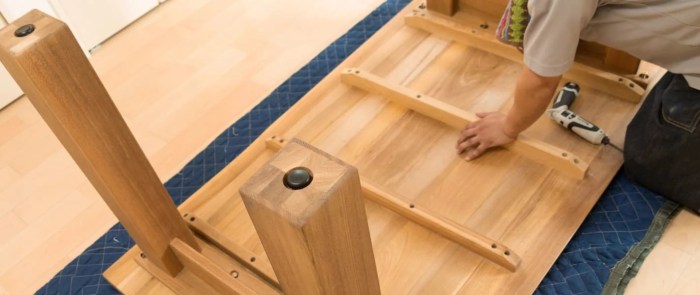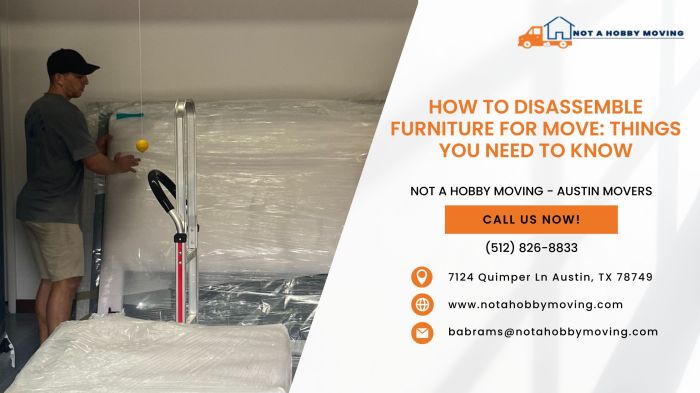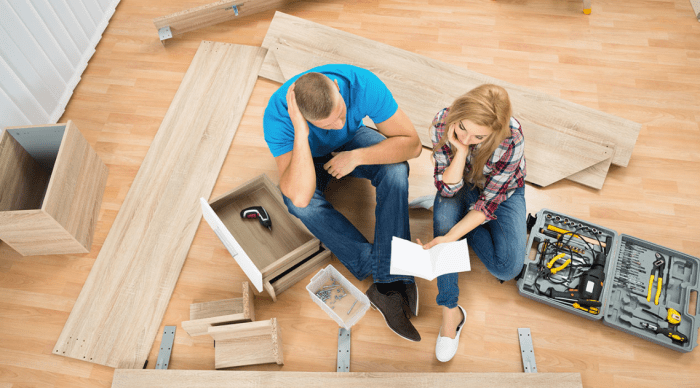Disassemble furniture for move – Embark on a journey of furniture disassembly for a seamless move, where every step is carefully planned and executed. Whether you’re tackling a dresser, a bed frame, or a beloved antique, this guide will empower you with the knowledge and techniques to dismantle and reassemble your furniture with ease.
As you delve into the art of furniture disassembly, you’ll discover the essential tools, safety precautions, and efficient tips to make the process a breeze. From removing stubborn hardware to safeguarding delicate parts, this comprehensive guide will equip you for every disassembly challenge.
Types of Furniture Disassembly
Furniture disassembly is an essential step when preparing for a move. It involves taking apart furniture pieces to make them easier to transport and reassemble at the new location. Different types of furniture require specific disassembly techniques to ensure they are handled safely and efficiently.
Stationary Furniture
Stationary furniture is typically large and fixed in place, requiring specialized tools and techniques for disassembly. Examples include:
- Built-in cabinets
- Shelving units
- Wall-mounted mirrors
Modular Furniture
Modular furniture is designed to be easily assembled and disassembled, making it ideal for frequent moves. Examples include:
- Sectionals
- Sofa beds
- IKEA furniture
Upholstered Furniture
Upholstered furniture requires careful disassembly to protect the fabric and cushions. Examples include:
- Sofas
- Chairs
- Ottomans
Appliances
Appliances such as refrigerators, dishwashers, and washing machines often require professional disassembly due to their electrical and plumbing connections. Examples include:
- Refrigerators
- Dishwashers
- Washing machines
Tools and Materials Required
Furniture disassembly demands a range of tools and materials to execute the task efficiently and safely. These resources can be categorized into three primary groups: hand tools, power tools, and safety gear.
Hand tools provide manual control and precision for intricate tasks. Essential hand tools include screwdrivers (Phillips and flathead), Allen keys, pliers, a hammer, and a utility knife. Power tools offer greater force and speed for larger components. A power drill with various drill bits and a reciprocating saw are recommended.
Safety gear is paramount to protect against potential hazards. Safety glasses, work gloves, and a dust mask are essential.
Hand Tools
- Screwdrivers (Phillips and flathead)
- Allen keys
- Pliers
- Hammer
- Utility knife
Power Tools
- Power drill with various drill bits
- Reciprocating saw
Safety Gear
- Safety glasses
- Work gloves
- Dust mask
Safety Precautions

Ensuring your safety during furniture disassembly is paramount. Mishandling tools and materials can lead to injuries and accidents, which can be easily avoided by adhering to proper safety measures.
Always wear appropriate safety gear, such as gloves, safety glasses, and a mask, to protect yourself from dust, splinters, and sharp edges. Additionally, ensure you have a clear and well-lit workspace to prevent tripping or mishandling tools.
Proper Tool Handling
Use the correct tools for the job and inspect them before each use. Dull or damaged tools can increase the risk of accidents. Keep sharp objects pointed away from yourself and others, and always cut away from your body.
Material Handling
Heavy furniture pieces should be lifted with proper technique to avoid back injuries. Bend your knees and lift with your legs, keeping your back straight. If the furniture is too heavy, seek assistance from others.
Electrical Safety
When disassembling furniture with electrical components, always unplug the power cord first. Never attempt to disassemble electrical appliances yourself unless you have the necessary qualifications.
Step-by-Step Disassembly Guide
Disassembling furniture can be a daunting task, but with the right approach, it can be done efficiently and safely. This guide provides a step-by-step process to help you disassemble your furniture with ease, ensuring that all components are protected and ready for transport.
Before you begin, gather all the necessary tools and materials. This may include screwdrivers, wrenches, pliers, and protective materials like bubble wrap or blankets. Ensure you have a clear workspace and ample lighting.
Safety Precautions
- Wear gloves and safety glasses to protect yourself from splinters or sharp edges.
- Handle heavy pieces carefully, and always lift with your legs, not your back.
- If you encounter any electrical components, disconnect them before disassembly.
- Keep small parts, such as screws and bolts, in a safe and labeled container to prevent loss.
Step-by-Step Disassembly
- Remove Hardware:Start by removing any visible hardware, such as screws, bolts, or knobs. Use the appropriate tools to avoid damaging the furniture or stripping the hardware.
- Separate Components:Once the hardware is removed, carefully separate the different components of the furniture. This may involve sliding out drawers, removing shelves, or detaching legs.
- Protect Delicate Parts:As you disassemble, pay attention to delicate parts, such as glass panels or upholstered cushions. Wrap them in protective materials to prevent damage during transport.
- Label and Store Components:As you disassemble each component, label it with the corresponding part of the furniture. This will make reassembly much easier.
- Check for Hidden Hardware:Some furniture may have hidden hardware, such as dowels or cam locks. Inspect the furniture carefully to ensure all hardware is removed before attempting to separate the components.
- Use Leverage Carefully:When disassembling large or heavy pieces, use leverage to your advantage. Avoid using excessive force, as this could damage the furniture.
Additional Tips
- Take pictures of the furniture before disassembly for reference during reassembly.
- If you encounter any difficulties, don’t hesitate to consult the furniture assembly instructions or seek professional help.
- Consider using a furniture disassembly service if you lack the time or tools to do it yourself.
Special Considerations for Different Furniture Types
Disassembling furniture requires specific considerations based on its type. Upholstered furniture, antique furniture, and furniture with electrical components pose unique challenges that require specialized techniques.
Upholstered Furniture
Upholstered furniture, such as sofas and armchairs, requires careful disassembly to avoid damaging the fabric or cushions.
Disassembling furniture for a move can be a daunting task, but it’s essential to ensure the safe transport of your belongings. Once your furniture is disassembled, you may wonder whether tipping is appropriate for the delivery crew. Do you tip for furniture delivery ? While tipping is not always expected, it’s a thoughtful gesture to show appreciation for the hard work involved in delivering your furniture safely and efficiently.
However, the decision of whether or not to tip is ultimately up to you.
- Remove cushions and pillows first.
- Use a screwdriver to remove screws holding the fabric in place.
- Carefully remove the fabric and stuffing.
- Disassemble the frame according to the specific design.
Antique Furniture
Antique furniture may require special handling to preserve its value and historical significance.
- Identify the type of wood and joinery used.
- Use appropriate tools and techniques to avoid damaging the wood.
- Consider consulting with a professional restorer if necessary.
- Document the disassembly process for future reassembly.
Furniture with Electrical Components
Furniture with electrical components, such as lamps or entertainment units, requires extra precautions during disassembly.
- Unplug all electrical cords.
- Identify and disconnect any wiring.
- Handle electrical components with care to avoid damage.
- Consider hiring an electrician if necessary.
Tips for Efficient Disassembly: Disassemble Furniture For Move
Disassembling furniture can be a time-consuming task, but there are several tips and tricks that can help you make the process more efficient. By optimizing the use of tools and materials and streamlining the disassembly process, you can save time and effort.
When preparing for a move, disassembling furniture can be a daunting task. If you’re looking for a stylish and functional way to upgrade your furniture, consider exploring aur house furniture . Their wide selection of high-quality pieces will complement any décor.
And when it’s time to move again, their durable construction will ensure your furniture withstands the journey with ease.
Planning and Preparation, Disassemble furniture for move
- Before you start disassembling furniture, take some time to plan and prepare. This includes gathering all the necessary tools and materials, as well as reading the manufacturer’s instructions.
- Make sure you have a clear workspace where you can work without obstruction.
- If possible, disassemble the furniture in a well-lit area.
Use the Right Tools
- The right tools can make disassembly much easier. Make sure you have a good set of screwdrivers, wrenches, and pliers.
- If you are disassembling a large piece of furniture, you may also need a power drill.
- Use the right size tools for the job. Trying to use a small screwdriver to remove a large bolt will only damage the bolt.
Follow the Instructions
- Many furniture manufacturers provide instructions on how to disassemble their products. If you have these instructions, follow them carefully.
- If you do not have the manufacturer’s instructions, you can usually find them online.
- Following the instructions will help you avoid damaging the furniture.
Take Your Time
- Disassembling furniture can be a delicate process. Do not rush through it. Take your time and be careful.
- If you are not sure how to remove a particular part, consult the manufacturer’s instructions or do some research online.
- Rushing through the process can lead to mistakes, which can damage the furniture.
Label the Parts
- As you disassemble the furniture, label the parts so that you can easily reassemble it later.
- You can use masking tape and a marker to label the parts.
- Labeling the parts will save you time and frustration when it comes time to reassemble the furniture.
Work with a Partner
- If you are disassembling a large or heavy piece of furniture, it is helpful to work with a partner.
- A partner can help you lift the furniture and hold it steady while you work.
- Working with a partner can also make the process more fun.
Reassembly Considerations

Proper reassembly is crucial after furniture disassembly to ensure the stability, functionality, and longevity of your furniture. Neglecting this step can compromise the integrity of the furniture and lead to premature damage or failure.
To ensure successful reassembly, it’s essential to organize and store the disassembled components carefully. Use clear labeling or containers to identify and group similar parts, making the reassembly process smoother.
Furniture moves can be a daunting task, but it doesn’t have to be. Disassembling furniture for the move can save you a lot of time and hassle, and it’s actually pretty easy to do. Plus, it can help prevent damage to your furniture during the move.
For tips and tricks on furniture moves, visit furniture moves . Disassembling your furniture for the move will make the process go much smoother and will help ensure that your furniture arrives at your new home in one piece.
Best Practices for Reassembly
- Follow the original assembly instructions:Refer to the manufacturer’s instructions for proper reassembly techniques and hardware specifications.
- Use the correct tools and hardware:Ensure you have the appropriate tools and replacement hardware to secure the furniture securely.
- Tighten all screws and bolts:Ensure all fasteners are adequately tightened to prevent loosening or rattling during use.
- Check for alignment and stability:Verify that the furniture is level, aligned, and stable before putting it into use.
- Handle with care:Avoid excessive force or rough handling during reassembly to prevent damage to the furniture components.
Ultimate Conclusion

With the furniture disassembled and ready for transport, remember that the journey is not over. Proper reassembly is crucial to ensure the stability and functionality of your furniture in its new home. Follow the tips and best practices Artikeld in this guide to ensure a successful move and a seamless transition for your beloved pieces.
FAQ Insights
What are the essential tools for furniture disassembly?
A screwdriver, wrench, hammer, pliers, and a utility knife are essential tools for most furniture disassembly tasks.
How can I safely disassemble upholstered furniture?
Carefully remove the fabric and padding to expose the frame. Use a screwdriver to remove any screws or bolts holding the frame together.
What are some tips for efficient furniture disassembly?
Organize your tools and materials, label disassembled parts, and use the right tools for the job to save time and effort.